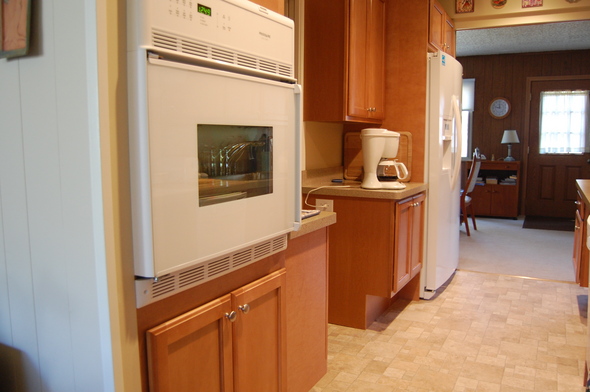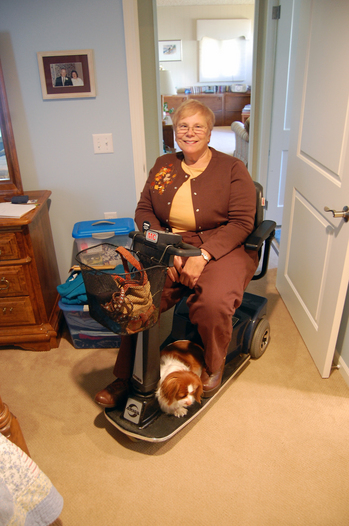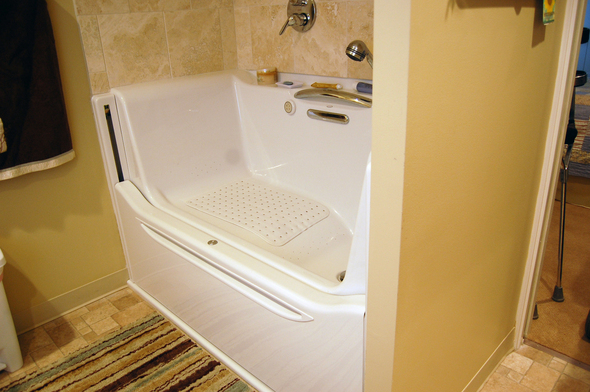A 'blooming miracle': Volunteers mount remodeling effort that allows woman with polio to stay in her Ann Arbor home

The new oven is at a height that makes it easy for Liina Paasuke to reach into and remove hot dishes.
Janet Miller | AnnArbor.com
But in the summer of 2010, all of that was in jeopardy.
Post-polio syndrome -- increasing weakness, fatigue and pain that appear long after the initially contracting polio -- was threatening to steal her independence, forcing her to use a scooter most of the time.

Post-polio syndrome make it impossible for Liina Paasuke to continue to live in her Ann Arbor house with some changes. The First Congregational Church came to the rescue with a volunteer work force and also helped with some of the funding.
Janet Miller | For AnnArbor.com
Yet, she didn’t want to move into an assisted living apartment. “I’m basically a feisty individual. I didn’t feel I was ready for that,” said Paasuke, who is retired.
She began thinking about remodeling her three-bedroom ranch to adapt for her physical challenges, but limited funds made it impossible to get everything she needed. “I was overwhelmed,” she said.
Her frustration spilled over when she attended a church group at First Congregational Church in Ann Arbor. The group had decided in lieu of a Christmas gift exchange, they would contribute to a church project, said Anne Harrington, a member of the group.
Then Paasuke’s situation presented itself.
“Liina couldn’t get into her bedroom. You can’t see something like this and not do something,” Harrington said.
The stars began to align themselves: Architect Scott Allen was a member of the church and volunteered his services. A friend had introduced Paasuke to someone who had finished an adaptive remodeling project who used the services of interior designer Nancy Krzesicki, who would go on to volunteer her services. And the church mounted a volunteer corps.
“Looking back, it was just a blooming miracle,” Paasuke said. “It’s not only a functional home, it looks nice. It was like getting a big group hug, so many people were so generous.”
Over the summer, about 40 volunteers worked along side the Valley Builders workers, demolishing the old kitchen, painting and installing the electrical system. A silent auction at the church raised $10,000 for the project and Paasuke re-mortgaged her house to pay for the rest.
Paasuke figures the volunteers reduced the project cost by about 30 percent. “I could never have done this without their help,” she said.
A non-slip floor was installed in the kitchen for the times when Paasuke gets out of the scooter and uses braces and crutches. A slippery floor can become a tragedy. “Crutches automatically divine to any water speck on the floor,” she said.
The kitchen was gutted and cabinets, positioned low enough for Paasuke to reach, were installed. Pullout shelves that lower to scooter level were built inside the cabinets. A cook top that she could reach was installed and a separate oven, with a door that opens on the side rather than down, was also installed. A microwave oven was placed below the countertop.

A state-of-the-art bathtub has one side that lowers, making it possible for Liina Paasuke to take a bath. It was big ticket item, and Paasuke gave the tub the name Goldie because it was so expensive.
Janet Miller | For AnnArbor.com
And the washer and dryer were moved to the master suite bathroom to make doing laundry easier. “That way, I don’t have to lug stuff through the house,” she said.
Paasuke’s story, Harrington said, not only calls attention to post polio syndrome, but also brings attention to remodeling alternatives that allow people to stay in their homes.


Comments
Chicagobob
Fri, Nov 18, 2011 : 5:33 p.m.
The First Congregational Church and the people in it must be wonderful : the kind of church I'd like to go to! BRAVO!
Linda Peck
Thu, Nov 17, 2011 : 12:23 p.m.
This is a beautiful story. Thank you for sharing it with us.
GirlNextDoor
Thu, Nov 17, 2011 : 11:35 a.m.
What a wonderful story about Liina, and her church, working together to keep her in her Ann Arbor home. Your remodeled home looks like a lovely place, and I'm so happy you are able to maintain your independence. My older brother contracted polio as a baby, when he was in the hospital, and I know first-hand how polio can rob an individual of the things many of us take for granted. Thanks again for sharing your story.